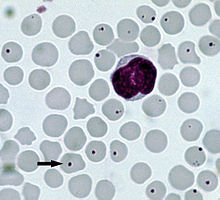| Anaplasmosis | |
|---|---|
 | |
| Anaplasma centrale infecting the red blood cells of a cow: The arrow points to typical infected cell. | |
| Specialty | Veterinary medicine |
Anaplasmosis is a tick-borne disease affecting ruminants, dogs, and horses,[1] and is caused by Anaplasma bacteria. Anaplasmosis is an infectious but not contagious disease. Anaplasmosis can be transmitted through mechanical and biological vector processes. Anaplasmosis can also be referred to as "yellow bag" or "yellow fever" because the infected animal can develop a jaundiced look. Other signs of infection include weight loss, diarrhea, paleness of the skin, aggressive behavior, and high fever.[2]
Many different tick species can carry the bacteria that cause anaplasmosis. The two major bacterial pathogens are Anaplasma marginale and Anaplasma phagocytophilum.[3] These microorganisms are Gram-negative,[4] and infect red blood cells.[5] Once the host is infected with anaplasmosis, the immune system will try to fight off and kill the infected red blood cells, but will also kill healthy red blood cells.[2] The Anaplasma sparouinense species is responsible for a rare zoonosis, the Sparouine anaplasmosis, detected only in French Guiana, South America.[6] This disease was described from a clandestine gold miner working deep in rainforest. Infection of his red blood cells led to a severe deterioration of his health and required his hospitalization. Molecular typing showed that Anaplasma sparouinense is distinct to all known species and more genetically related to recently described Anaplasma species causing infections in rainforest wild fauna of Brazil.[6]
While there are no current live or inactivated vaccines effective for all strains of A. marginale approved by the USDA for anaplasmosis, there are other means of prevention. Tick and fly control for herds of ruminants can be effective but also labor intensive. Chemical methods can also be used, including sanitizing surgical equipment after each use.[3] Tetracycline drugs are the most common treatment for anaplasmosis, and can provide the animal with immunity for a period of time.[7] The disease is more common in the South and West parts of the United States, but is no longer considered a major problem since the use of tetracycline drugs.[8]
- ^ "Anaplasmosis". Pennsylvania Game Commission. Archived from the original on 2022-05-24. Retrieved 2021-11-29.
- ^ a b Whittier WD, Currin N, Currin JF (2005-09-01). Anaplasmosis in Beef Cattle. Virginia Cooperative Extension. OCLC 1200163698.
- ^ a b Cite error: The named reference
:3was invoked but never defined (see the help page). - ^ Hartelt K, Oehme R, Frank H, Brockmann SO, Hassler D, Kimmig P (April 2004). "Pathogens and symbionts in ticks: prevalence of Anaplasma phagocytophilum (Ehrlichia sp.), Wolbachia sp., Rickettsia sp., and Babesia sp. in Southern Germany". International Journal of Medical Microbiology. Proceedings of the VII International Potsdam Symposium on Tick-Borne Diseases. 293 (Suppl 37): 86–92. doi:10.1016/S1433-1128(04)80013-5. PMID 15146989.
- ^ Capucille DJ (2011). "Anaplasmosis". In Haskell SR (ed.). Blackwell's Five-Minute Veterinary Consult Ruminant. Hoboken: John Wiley & Sons. pp. 50–51. ISBN 9780470961186.
- ^ a b Duron O, Koual R, Musset L, Buysse M, Lambert Y, Jaulhac B, et al. (August 2022). "Novel Chronic Anaplasmosis in Splenectomized Patient, Amazon Rainforest". Emerging Infectious Diseases. 28 (8): 1673–1676. doi:10.3201/eid2808.212425. PMC 9328922. PMID 35876693.
- ^ Cite error: The named reference
:5was invoked but never defined (see the help page). - ^ Cite error: The named reference
:6was invoked but never defined (see the help page).